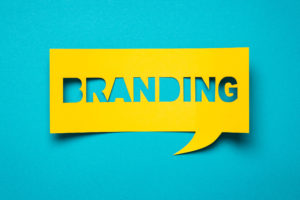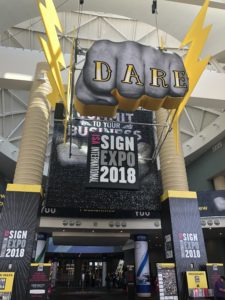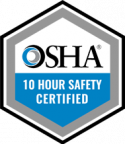While signs come in an array of shapes, sizes and materials, many signs are made of a substrate that then has vinyl or other mediums applied on top of it. A substrate is defined as “a substance or layer that underlies something, or on which some process occurs.” (source) In signage, a substrate is known as the backbone of a sign, and can be temporary or permanent in nature. There are several different standard substrates used in the signage industry, including everything from banner material to foamboard, to acrylic or aluminum. Vinyl, which is often the substance that is adhered to substrates, also comes in different grades. From cast to calendared vinyl, it’s important to know which vinyl is best for your sign. We’ll go through the most popular types of substrates and vinyl materials and outline the different uses and applications of each.
SUBSTRATES
Standard substrates vary in thickness, material and durability. Starting with one of the more temporary substrates, banner stock is a popular option for promoting products and services. Banner material is typically differentiated by weight, with the different weights referring to how much the material weighs per yard. This means the higher the ounce, the heavier the material is. 10 ounce banner stock is the minimum weight for exterior use and weather resistance, but 13 ounce is industry standard. Banner material can also be reinforced with a polyester mesh called skrim that strengthens the material. Its can be directly printed onto with any colored graphics, and comes in a wide array of lengths and widths.
Foamboard is the lightest weight of all substrates. Made of a polystyrene core with heavyweight coated paper, it is a great option for temporary interior signage. Before working with foamboard, ensure that the type being provided is plastic coated so it can withstand humidity. It’s a great option for exhibits, displays and promotional specialties due to its lightweight nature and low cost. Foamboard isn’t as durable as other substrates, so it is not recommended for any exterior signage. Foamboard’s cousin Gatorboard offers the same lightweight material, but has more resistance to denting or creasing as it has the same polystyrene core but with a wood fiber veneer.
Used for political signs, golf tournaments and realtor signage, coroplast is the go-to material when it comes to temporary yard signage. It is made up of a unique plastic board with superior toughness, durability and printability. Not affected by moisture, it can withstand the elements. It also has built-in UB stabilization, protecting it from sunlight. Coroplast can be ordered in several colors and thicknesses.
When most people think PVC, they think plumbing parts, but did you know it’s also a common substrate in the signage industry? It is used because its light-weight, hard-wearing and resists most chemicals. It’s also water resistant and comes in a variety of thicknesses and colors. The downside to PVC is that it has minimal UV colorfastness, so it should only be used for interior signage. For this reason, it’s recommended for indoor displays and tradeshows, for use in restaurants and for special events.
For a substrate that is removable and re-usable for cars, truck and other uses, magnetic backing is the go-to. It is a non-porous material that is highly magnetized and has a firm hold. For companies with vehicles that often change, a magnetic substrate sign with vinyl graphics printed on top is a great option as it is easily transferable. Depending on the type of magnetic backing and the vinyl printed on top, signage using this substrate can range from temporary use to semi permanent.
An extremely versatile and customizable substrate, acrylic is the go-to for many signage products, including several that we have fabricated and installed in the Kansas City area. It comes in many different thicknesses, with 3/8” being the most popular. Vinyl graphics or logos can be applied on top, or acrylic sheets can be routed into custom letters and logos. It is also durable, making it a great permanent option for indoor or exterior signage.


Another signage substrate that is often used is an aluminum composite called Dibond. Dibond is two aluminum panels sandwiched in between a PVC core. This gives it half the weight of a regular sheet of aluminum, but keeps the durability. Dibond is a great substrate for exterior signs as it has high corrosion resistance. It comes in various sizes of sheets with thicknesses of either 3MM or 6MM. Dibond is recommended for vinyl application, forming signs with curves and destination/warning signs.

A monument sign made of Dibond with vinyl graphics
For permanent signage, aluminum has a long shelf life that can withstand the elements for years. With a 10+ year life span, it can be used for interior or exterior signage. It also has excellent stain-resistance and long lasting finish. Aluminum is heavier than other substrates, something to keep in mind when thinking about the size of your signage. It is also a premium substrate, and thus typically has a higher price tag. It is great for long-term signage though, and thus is recommended for outdoor usage including parking signs, directional and wayfinding signage.
VINYL
Now that we’ve talked about options for the backbone of signage, it’s time to move onto the exciting part: what makes the sign stand out. Vinyl graphics and letters are a way to make your sign pop, give it a customized look and call out information to your viewing audience. Vinyl itself comes in many different variants, which is why it’s best to know what each is suited for. The two most widely used types of vinyls are called cast and calendared vinyl.
Cast vinyl is a superior vinyl which has high performance. It can withstand the elements for 5-7 years, making it a great option for exterior signage. Cast vinyl is made using a process that allows it to be very thin and flexible, making it excellent for vehicle and truck graphics.
If cast vinyl is king, then calendared vinyl is the prince of vinyl. Sometimes referred to as intermediate vinyl, calendared vinyl is thicker and thus less flexible than cast vinyl. Calendared vinyl can last anywhere from 1-7 years. Less expensive than cast vinyl, it is ideal for interior signage as well as short term outdoor banners and signs.
IN SUMMARY
When looking at what signage fits your needs, its important to be educated on the different materials. Knowing what standard substrates are available in the sign industry will ensure you get the type best suited to your project. For temporary signage banners, foamboard, PVC and coroplast are great options. If you need something permanent and long-lasting, acrylic, dibond and aluminum are a better fit. Knowing your vinyls also ensures you get the best bang for your buck. If you’ll using the same signage for at least 5 years, it is better to go with cast vinyl knowing it has a longer shelf life. Not sure if you’ll want to switch things up in a year or two? Save some money and specify that you would like to use calendared, or intermediate vinyl.
Does this article get you excited about signage? Visit the contact us page and get started on your next project today!











